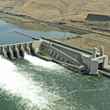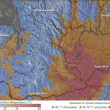(She throws up her hands, pushes her chair away from the ponderous pile of papers, and barks an epithet worthy of a pissed off sailor.)
These forms and computations are ridiculous! I’ll never get this done by the 15th.
Sorry to hear that, dear. Can I get you something?
No, I just need a break. Clear my head. What are you up to?
Just getting my gear ready for spring bass fishing.
What kind of fishing pole is that?
Fly rod. It’s a fly rod. Not a fishing pole.
(She knows this, but likes to pull my chain.)
It’s a 6wt. My favorite stick for our Haw River shoals bass.
What does 6wt mean?
It means that it’s a rod that is used to throw a 6wt line.
That’s awkward. Naming something because it’s used with something else.
I guess.
What’s a “wt”?
It has something to do with how much the first 30 feet of the line weighs, though I suspect few folks know the exact parameters. You usually just buy it to match the rod you have.
The rod is numbered based on the line that you need but you buy the line based on the rod that you have?
(I shift uncomfortably on my feet. She gives me a break and doesn’t dig deeper.)
So that’s a 6wt line then, right?
Well, no. It’s a 7wt line. This 6wt rod’s a bit fast, acts like a bigger stick, so I like to up-line it a step.
Then it should be called a 7wt pole.
Rod. And no, I don’t think so.
(She looks at me, expecting a better explanation. I’ve got none. After an uncomfortable minute, she shrugs and moves on.)
And that string on the end. Is that a 6wt or 7?
That’s a leader. And no, it’s a 2X.
2X. Okay. So that’s lighter weight than a 6wt?
Well, not really. It’s apples and oranges, lines and leaders.
Okay. Would, perhaps, a 4X, a heavier leader, be better sometimes? Up-leadering?
Umm, maybe. But, actually, a 4X is lighter than a 2X. Rod and line numbers go up as they get bigger. Leader size goes down.
Oh. That’s confusing. And the fly. Is it a 6wt, 7wt, or 2X?
(Gulp)
It’s a small clouser. A #8.
#8. You’re kidding. Do those numbers go up, or go down?
Bigger numbers are smaller flies. Like leaders.
Good grief. And the reel? What number is that?
Well, that depends on who made it. All manufacturers seem to have their own numbering systems.
You realize, of course, that none of this makes sense. Your 6wt pole – I mean rod – named in an endless loop of “which came first” with the line, should really be a seven. Your leader numbering is completely different and goes down instead of up, like your flies, but on a completely different scale. And your reels are, well, who knows about your reels? Have I got this right?
(I’m defenseless.)
Yes, you’ve got it right. But once you get accustomed, it all makes sense. It’s all odd numbering systems based on history and innovation, effected by interactions with one another with slippery sorts of guidelines and rules. It’s a hodgepodge, and can be confusing as hell to the uninitiated, but I think I’ve gotten it pretty well figured out.
Perfect. Sounds just like our taxes. They’re all yours, bucko. I’m going out and work in the garden.
































Comments
Chippy replied on Permalink
The only thing that really grinds my gears with all the fly-fishing number systems is line weight (thanks to over-weight lines and stiffer sticks). Would it really screw up the industry that much to just sell lines by grain weight, and thusly have rods labeled with a suggested grain weight range?
Mike Sepelak replied on Permalink
And don't get me started on intermediate and sinking, tapers, et al. A physicists nightmare.
Todd Tanner replied on Permalink
It's funny, Mike, but the thing that really rubs me raw is the chicken & egg nature of rod and line weights. Seriously, think about it:
We choose a line based on the task at hand - say, casting a bugger for trout.
Then we grab a rod designed to cast that line. Let's say a 6 wt.
Which would be fine if the rod manufactures didn't feel like they could sell more rods by making them stiffer and faster. Which, coincidently, means that your new 6 wt rod is actually better suited to a 7 wt. line.
Which we could live with if, in their infinite wisdom, the line manufactures didn't turn their 7 wt. lines into a 7.5 wt. line (common) or an 8 wt. line. (Also known to happen.)
So now, nobody really knows what the hell they're fishing with. A 5wt rod might be a 5 wt. rod. Or it could be a 6 wt. A 5 wt. line might be a 5 wt. line. Or it could be a 5.5 wt. Or a 6 wt. And if you decide to over-line your rod by a size, you might be putting a 6 wt. line on a 5 wt. rod (bad), a 6 wt. line on a 6 wt. rod (good), a 6.5 wt. line on a 5 wt. rod (really bad), a 6.5 wt line on a 6 wt. rod (probably not an issue), a 7 wt. line on a 6 wt rod (bad), or a 7 wt. line on a 5 wt. rod (horrible). Because nobody knows what the numbers mean any more.
Abbott and Costello could have a field day with this. It's the modern version of "Who's on First."
Mike Sepelak replied on Permalink
Couldn't agree more, Todd. It makes depreciation tables look like child's play.
Ken G replied on Permalink
At tax time, accountants are worth whatever they say they're going to charge you. Gave up on mine over quarter of a century ago and have no intention of ever doing anything to one of those forms other than sign them where the accountant says to... and you're getting this much back... yeah, whatever, where do I sign.
Mike Sepelak replied on Permalink
Amen, Ken.
Pages